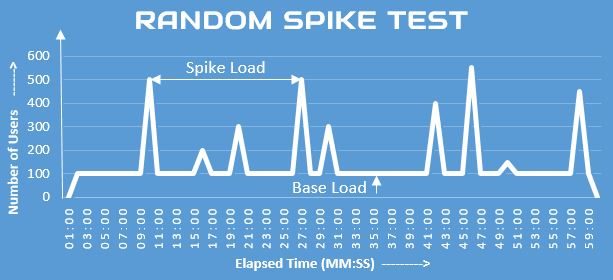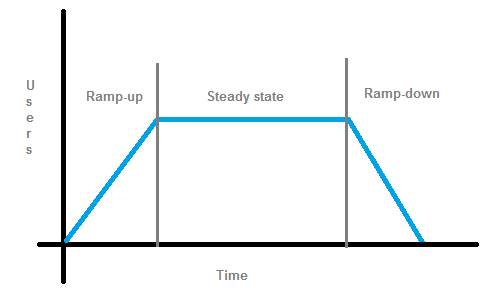
Spike testing is a type of performance testing in which an application receives a sudden and extreme increase or decrease in load.
- What is Spike Testing?
- Goals of Spike Testing
- How to do Spike Testing
- Examples of Spike Testing Scenarios
- Recovery Scenarios on Spike Loads
- Objectives of Spike checking out
- Workload Models in a Spike Test
- Types of Loads for Designing Workload
- Advantages of spike Testing
- Disadvantages of spike testing
- Peak Test Tools
- Conclusion
What is Spike Testing?

Spike Testing is a form of software program trying out wherein a software program utility is examined with excessive increments and decrements in visitors load. The major reason of spike trying out is to assess the behaviour of the software program utility below surprising increment or decrement in consumer load and decide healing time after a spike of consumer load. Spike Testing is done to estimate the weaknesses of software program applications.
- The purpose of Spike checking out is to look how the machine responds to surprising upward thrust and fall of the person load. In Software Engineering Spike checking out allows decide machine overall performance will deterioration whilst there’s a unexpected excessive load.
- Another purpose of Spike Testing is to decide the recuperation time. Between successive spikes of person load, the machine desires a while to stabilize. This recuperation time have to be as little as possible.
Goals of Spike Testing:-
- Step 1: Determine the Load Capacity- Determine the Maximum User Load potential of your software program utility.
- Step 2: Prepare the Test Environment- Prepare the Testing Environment and configure it to report overall performance parameters.
- Step 3: Define Expected Load- Apply anticipated most load in your Software Application the use of a Performance Testing Tool of your choice.
- Step 4: Increase the Load- Rapidly boom the weight to the machine for a hard and fast period.
- Step 5: Set the Load again to Normal- Gradually lessen the weight again to its unique level.
- Step 6: Analyse the Results- Analyse the overall performance graphs and metrics like Failures, Time Taken, Virtual Users, etc.
How to do Spike Testing:-

Here are the easy steps to carry out Spike Testing:
- When an internet utility is stay streaming a fave TV program.
- When a flash sale goes on a every day deal web website online.
- When the positive content material of a domain is going viral over the Internet.
- A new machine is launched for production, and a couple of customers need to get admission to the machine.
- A strength outage can also additionally motive all customers to lose get admission to to a machine. After the outage difficulty resolved all customers then log again onto the machine simultaneously.
Examples of Spike Testing Scenarios:-
When an eCommerce save is launching unique offers with first-rate reductions consisting of on Black Friday.
- Use cloud structures like AWS, Azure to dynamically boom server potential in tandem with the person load
- Do now no longer permit the utility-get admission to to a few customers, in order that machine does now no longer face heavy load. This stops human beings above the most designed load from getting into the machine. Thus protects the machine from the danger of an immoderate load.
- The web website online admin permits customers to enroll in the machine. However with caution that they will face sluggish reaction due to heavy load. This can also additionally bring about the unfavourable impact at the machine overall performance. However, the person may be capable of paintings with the machine.
Recovery Scenarios on Spike Loads:-
Three essential recuperation situations that may be configured to defend in opposition to Spikes are:
- Determine recuperation time after every spike.
- To decide weaknesses of the machine or the utility.
- To examine software program’s reaction time at some stage in a spike.
- To decide its overall performance at some stage in and after a spike.
Objectives of Spike checking out:-

To test if the machine will continue to exist the unexpected increments and decrements in workload (sustainability of the machine).
- Constant workload spike model
- Step-Up workload spike model
- Random workload spike model
Workload Models in a Spike Test:-
- Base Load: is the average user load given to the system to observe its daily performance.
- Peak Load – A sudden increase in load to observe how the system reacts to it. These loads are managed to verify that the system can handle an increase in user numbers in real life.
Types of Loads for Designing Workload :-

- Determining the consequences of unexpected spikes for end users.
- Determine how much an application can do beyond its intended load.
- The ability of developers to prevent an application from being interrupted if the user unexpectedly loads past the maximum values.
Advantages of spike Testing:-
- The requirement of a separate, specific test environment.
- High costs of money, resources and time.
Disadvantages of spike testing:-
Peak Test Tools :-
1.JMeter – Apache JMeter is an open source Java peak test tool. It is specifically designed to load functional test behavior and measure performance. Web application or a variety of services. Today it is widely used for functional testing and database server testing.
2. LoadRunner – LoadRunner is a load testing tool for Windows and Linux that enables spike testing of web and other applications.Helps determine application performance and result even under heavy load.
Conclusion:-
Spike Testing is a type of software test that tests a software application with an extreme increase and decrease in traffic. The correct approach to spike testing is to unexpectedly increase the number of users, followed by an immediate decrease in load. Unexpected loading is the main characteristic of the business.
Examples of real spike test scenarios are: when an e-commerce shop launches heavily discounted specials such as Black Friday or when a web application broadcasts a favorite TV show live. JMeter is such a useful tool for peak testing.





